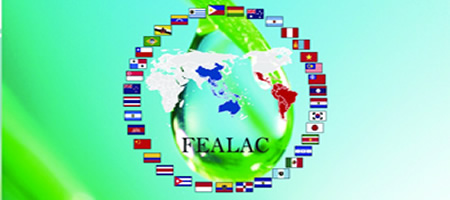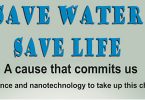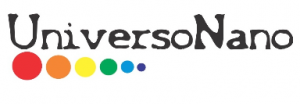
Cbionano-FEALAC Bio-Nano Convergence Network
Environment and Energy: Challenges and opportunities from bio and nanotechnology
For the Network’s Phase 1 and 2, the identification and fulfillment of the commitments agreed by the members of the Bio-Nano Convergence Network, regarding the joint formulation and management of projects within the area of bio-refineries and bio-nanotechnology, were proposed as its key goals. These two areas of knowledge were considered as the “focal points of convergence” for this initiative.
Edgar E González
Coordinator, Bio-Nano Convergence Network
The Forum for East Asia- Latin American Co-operation (FEALAC) is a conference where twenty (20) countries from Latin America and sixteen (16) from East Asia currently participate. It places its main focus the strengthening of political, cultural, educational, social, economic, scientific and technological relations amongst member countries. Both Colombia and Japan have recently been appointed co-chairs of the Work Group on Science, Technology, Information and Education.
Preliminary work led by the joint action of the Colombian Presidential Agency of International Cooperation (APC), the Administrative Department of Science, Technology and Innovation – COLCIENCIAS -, the Ministry of Foreign Affairs, and the Colombian Association for the Advancement of Science, resulted in the development of Phase 1 within the consolidation of the Network of scientific-technological convergence. The proposal was presented to all FEALAC countries in June 2013, during the 9th meeting held by the Science and Technology Working Group in Bali, Indonesia.
Phase 1 resulted in the identification of a number of groups and researchers as well as a number of key areas of interest, from which, it was decided, the main focus should specifically be placed on nanotechnology and bio-refineries. As a result of this preliminary work, an outline of the main task was drawn for Phase 2, hence, allowing it to set the Network of Bio-Nano Convergence (Cbionano-FEALAC), which was developed under the institutional coordination and execution of COLCIENCIAS, with the support of the Ministry of Foreign Affairs, APC and ACAC.
As a result of all the activities carried out in phases I and II, the main aspects that guide the development of this initiative were agreed. From international workshops held, the working groups proposed as components to be addressed within the framework of cooperation projects between countries that are part of FEALAC:
i) Detection, measurement, monitoring of heavy metals into water;
ii) Nanoremediation;
iii) Bioremediation;
iv) Biorefineries.
Basis of Interest
Two key areas of convergence were identified once problems concerning the member countries were reviewed: environment and energy. These areas play an important role in research, innovation and development policies due to their social impact and relevance to member countries.Some initiatives, encouraging open and wide consultation with relevant experts and key members of the community in order to identify the main issues that modern societies within the 21st century have to cope with at a global level, show that there is consensus when considering that issues regarding energy, water and the environment are part of the key challenges that must be addressed urgently and effectively in order to guarantee the planet’s sustainability.
The proposal consists in addressing environmental issues placing the focus on contamination produced by heavy metals in fresh water resources. All countries within FEALAC are to a greater or lesser extent affected by this complex problem, which in addition to causing serious damage to the environment, also compromises food safety and the health of the population exposed to this sort of contaminant.
Hence, in the specific case of contamination produced by arsenic on fresh water for human use in South and East Asia, some 50 million people are exposed to concentrations of arsenic with values higher than those recommended by relevant environmental and health authorities. In Latin America, it is estimated that some 5 million people are exposed to contamination produced by this metal.
Governments of a large number of countries affected by contamination by heavy metals have formulated programs and policies oriented to obtain information and prepare mitigation and remediation plans regarding the presence of heavy metals.
In Colombia, due to the significant problem that contamination by mercury poses at present, the Ministry of Environment and Sustainable Development launched a Unified National Plan providing clear guidelines on transfer of technology, promoting the use of clean technologies, encouraging training, and building awareness on the use of mercury and products containing it, in a drive to minimize its impact and protect public health and the environment from its effects. On the other hand, the Colombian Nanoscience and Nanotechnology Network has established as one of its priority tasks the need to tackle contamination by heavy metals from the perspective of nanoscale technologies, specifically by means of measurement, monitoring, mitigation and nano- remediation.
Despite the fact that within FEALAC countries there has been a number of initiatives aiming at monitoring, mitigating and remediating heavy metals present in fresh water for human consumption, there is a call to increase cooperation and joint research in an effort to address this serious environmental problem. Some countries lack information regarding the degree of contamination by this sort of contaminant and the size of the population exposed to it in excess of recommended values remains unknown.
Bio/nano-technology offer new avenues for detection, measurement, monitoring, and remediation. There is no doubt that progress in detection, measurement and monitoring has been achieved by means of this technology. Within many FEALAC countries there is capacity to develop low-cost, high precision portable processes and systems. From a remediation point of view, one of the most important contributions that have sprung from the revolution that nano-technology entails has been the production of nanomaterials, which involves, in turn, innovative and exceptional properties relevant to the completion of this sort of tasks.
Likewise, bio-refinery offers an important opportunity to live up to energy challenges with a high degree of sustainability and environmental commitment, in tandem with the valuable contributions made by biomaterials when applied – amongst other uses- to heavy metal remediation. It is convenient that remediation tasks as well as energy production are framed in a single holistic context, in which strategies for remediation may be set up in conjunction with energy production, maintaining an optimal balance between results and the impact caused on the environment and living beings in general. This methodology demands that the toxicological effects and life cycle of processes and nanomaterials used must continuously be assessed.
It is beyond question that by means of the execution of this sort of projects, FEALAC leadership as a forum for the actual economic and political integration of member countries will be strengthened, hence contributing in the development of scientific knowledge and the application of technology, benefiting, as a result, both regions.
INTERNATIONAL WORKSHOP
Bio-Nano Convergence Network, Phase 2:
Environment and Energy:
Challenges and Opportunities from Bio and Nanotechnology
Participants
The international workshop was attended by 350 researchers in energy and environment, academic authorities, public and private functionaries, entrepreneurs, teachers and advanced students in the area of nano and biotechnology, among others.
Guest speakers:
JAPAN: Katzuro Anazawa, Tokio University
KOREA: Hor-Gil Gur, Gwangju Institute of Science and Technology
ARGENTINA: Roberto Candal, CONICET & Universidad San Martín.
MEXICO: María Teresa Alarcón, CIMAV Unidad Durango
CHILE: Mariella Rivas, Universidad de Antofagasta
COSTA RICA: José Vega-Baudrit, LANOTEC
ECUADOR: Chulde Vladimir, INER & Spiros N. Agathos, Universidad Yachay Tech
COLOMBIA: Nelson Obregón, Universidad Javeriana/ Janeth Sanabria, Universidad del Valle/ Jorge Enrique López, Pro-Biorefinery, Universidad del Valle/ Luz Marina Flórez, Universidad Autónoma de Occidente.
FEALAC-Cbionano International Workshop: ENVIRONMENT & ENERGY
Topics covered in the plenaries
The topics covered in the workshop were:
Detection and measurement of heavy metals in water.
Bio and nanoremediation of heavy metals in water.
Biorefinery, a strategic route to address the energy problem.
The main aspects presented in the plenary were:
The role of microorganisms for removal of heavy metals. Interaction processes of microbes and metals as well as the formation of nanomaterials were presented. From such interactions it is possible to develop strategies that address the problem of remediation of heavy metals in water. As specific cases, iron mineralization, formation of magnetite, siderite, iron oxyhydroxide nanowires among others, were treated.
Universal access to clean water and sanitation as one of the Sustainable Development Goals, governance, quality improvement, wastewater management with reduced risk and vulnerability are some of the main issues addressed in the nano-context of remediation of water contaminated with metals and metalloids.
The pollution problem by heavy metals and metalloids in Argentina was presented. In Latin America, 14 million people are exposed to the effects of arsenic contamination in water, with 4 million in Argentina. With the use of bio-clays, are setting remediation solutions for waters contaminated with heavy metals and metalloids such as arsenic.
As a case study, the behavior of dissolved heavy metals were investigated on the acid mine water in a vicinity of an abandoned copper mine. The heavy metal concentrations in the river water downstream of the mine were in the range of background level around the investigation area. Simulations found that with a simple neutralization tank extraction capacities between 77-100% of the heavy metals are obtained.
In the case of Colombia, mercury contamination resulting from mining activity in the Mojana region was presented. The Mojana region is one of the most complex water systems and one of the most mercury-contaminated places in the world. It was proposed to consider this region as a pilot to study the problem of contamination by heavy metals, particularly mercury.
Enzymatic, molecular and cellular transformations in sustainable and scalable technology systems. Multi-scale methodologies become possible with biosynthetic bioremediation and optimization. It is recognized in algae an important means of treatment of wastewater and energy production with sustainable integration of refinery waste and recycling.
The biocells microalgae and agro-industrial waste from a biorefinery concept with recovery from biomass, opens an important avenue of potential solutions to energy and environmental problems. The need for research with biomass that does not compete with food and land use was highlighted. The advantages and potential offered unconventional biogas as renewable energy and the role of microalgae in these energy production processes were presented.
Pyrolysis of waste biomass for generating microwave bioproducts and biofuels, as an alternative to conventional was presented.
Costa Rica is known for being one of the “greenest” countries. One of its goals for 2021 is to achieve leadership as carbon neutral country and a way to achieve it is through the biorefinery.
You may also like

Good practices and responsible..
Development of best practice guidelines for the handling of nanomaterials
read more
Save Water, Save Life
Integrates students from schools in the search of solution and active participation in the mission […]
read more
















Leave a Reply